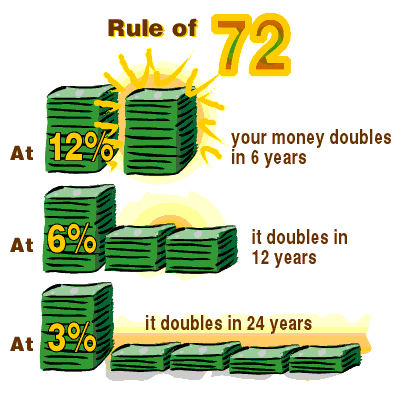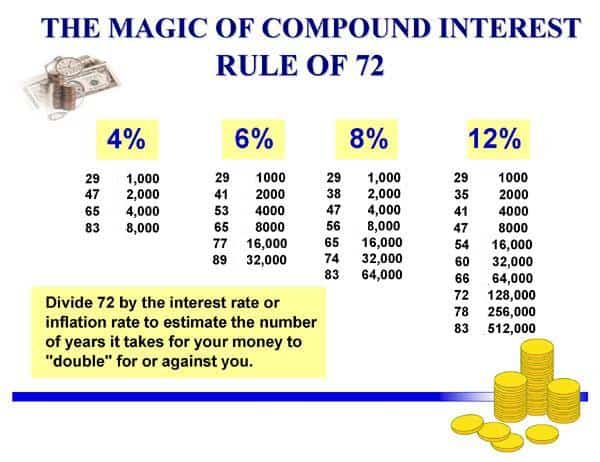31st October is celebrated as World Savings Day but what a coincidence Halloween is also celebrated on the same day. (tragedy is we know about Halloween but….) Let’s learn some basic rules that you can practically apply in your day-to-day life.
The ‘Rule of 72’ is a simple way to determine how long an investment will take to double, given a fixed annual rate of interest. By dividing 72 by the annual rate of return, investors can get a rough estimate of how many years it will take for the initial investment to double itself.
For example, the rule of 72 states that Rs 1 invested at 10% would take 7.2 years (72/10 = 7.2) to turn into Rs 2. In reality, a 10% investment will take 7.3 years to double (1.10^7.3 = 2). When dealing with low rates of return, the Rule of 72 is fairly accurate. Albert Einstein said compounding is eighth wonder of this world & “rule of 72” eight wonder. Below chart compares the number of years it takes an investment to double at certain rate.

Investment Guru – why you should avoid them?
Every Penny Counts
Let’s try to practically apply this rule. Let’s assume that as today is World Savings Day – you added Rs 1000 to your retirement kitty. (assuming you are 29)

WOW! So if someone save Rs 1000 today for his retirement – it will become Rs 32000 in 30 years or Rs 64000 in 36 years.(@ 12%) Just imagine if this amount is Rs 10000 this month (if you don’t splurge in the festive season) or Rs 1 Lakh this year (bought a small car or vacation or may be combination of many small things).
There is also a reverse usage of rule of 72 – where you divide 72 by number of years & you will get the rate at which money will double in this period. Similarly there are 114 (triple) or 144 (quadruple).
Must Read: Top 10 Financial Planning Rules of Thumb
Super Mario Rules

Image Source
Question: India’s annual population growth rate is 1.3% (China’s .5%) –
how many year it will take us to cross 200 Crore. 🙂
Too Good. Thanks for sharing it..
Super-like! The way the common “rule of 72” is explained with examples and graphics,it is bound to hold the interest of readers and is also very easy to understand for non-finance people.
It’ll take 55.38 years for India to cross 200 Crores & 144 years for China…
what about rate of death in India VS China 🙂 ?
The best part about reading your articles is – each and every word enhances my interest in investments and learn more about the ways I can invest.
Thanks for this one. 🙂
Mario graphics used here is superb way of explaning thumb rules of financial planning
Hi Hemant
Never thought, mario can be explained in such a beautiful way. Although i have played it throughout my life, but still loved the way,you have explained it.
g8 job hemant ur articles are superb
very good for common man to look for
finances rule 72 ,114,144 are g8 to understand
power of compounding.
But Hemant considering inflation @10%…todays Rs 1000 would be equivalent to Rs 1.6 Lakh 54 years down the line..if i have calculated rightly!
Hi Amit,
Fully agree with you but does that mean someone should not save or save more 🙂
Sir, very very nice…..But also please infrom where can we get 12 % interest P.A , it is through SIP or Debt market which is the best investment plan, so we can get the 12 %
Well written…loved reading this article.
Hello Hemant,
Great Article. Thanks for Sharing Facts in a simple Way…
Hi Sir, Every articles of yours are worth reading. But here im stuck with Where to start. Sir, is it wise and advantage to do SIP in MF for a term of 10-15years through portals like fundsindia.com or fundsupermart.com? Or to follow each AMC for each fund?
I’d notice less fees and convenience in privately owned portals like fundsindia.com or fundsupermart.com.
Sir, i need your suggestion Please.
Happy Diwali……
Hi popo,
Funds India a good platform for investing. With AMC you will have to do it seperately and then manage your portfolio. But with online option available with them now it should also be convenient. Avail which is more comfortable to you.
Beautiful article.
Hi Hemant,
Thanks for this article. I increase my knowledge by your articles. . i m a govt. employee as a electrical engineer & my salary is 5.0 lacs/yr. now I want 2 share my portfolio. Please guide me if there r any mistake.
My portfolio as:-
1.Each Rs. 1000/- SIP in HDFC TOP200 , ICICI BLUECHIP & HDFC PRODENCE FUND & 500/- HDFC GOLD FUND. (Total SIP Rs. 3500/- per month).
2. Approximately 8000 in HDFC TAX SAVING FUND yearly in lumpsum
3. Rs. 1000/- RD for 10 year term with 9.5% interest rate.
4. Rs. 30000/- to 50000/- in PPF Account.
5. I have a term plan 25 lacs in Birla Sun Life.
6. Approximately 40000/- CPF deductd by my employer.
will be waiting for your help.
Hi Avi,
You have a decent portfolio and well diversified. However, good to analyze your requirement first so that you can align these investment with specific requirements.
You can look at increasing your insurance coverage to about Rs 50 -60 lakh.
thank u, ur sir, very very nice.
Sir,
Iam 50 years old and a senior PSU employee. Is am i too old to start financial planning ? Is it possible to manage my finances at this age along with retirement plans and insurance requirements and other goals as i will retire at 60years. I hope you understand and guide me. I am totally confused.
Hi Srinivas,
You should check these videos.
https://www.retirewise.in/2010/11/financial-planning-retirement-planning-guide.html
Nicely articulated with good illustration on the rule of 72.
You wrote this article in October 2012. I just read it (April 2014) It is a really nice article. The power of compounding does go a long way!
hey,its superb way of explaning thumb rules of financial planning
Comments are closed.